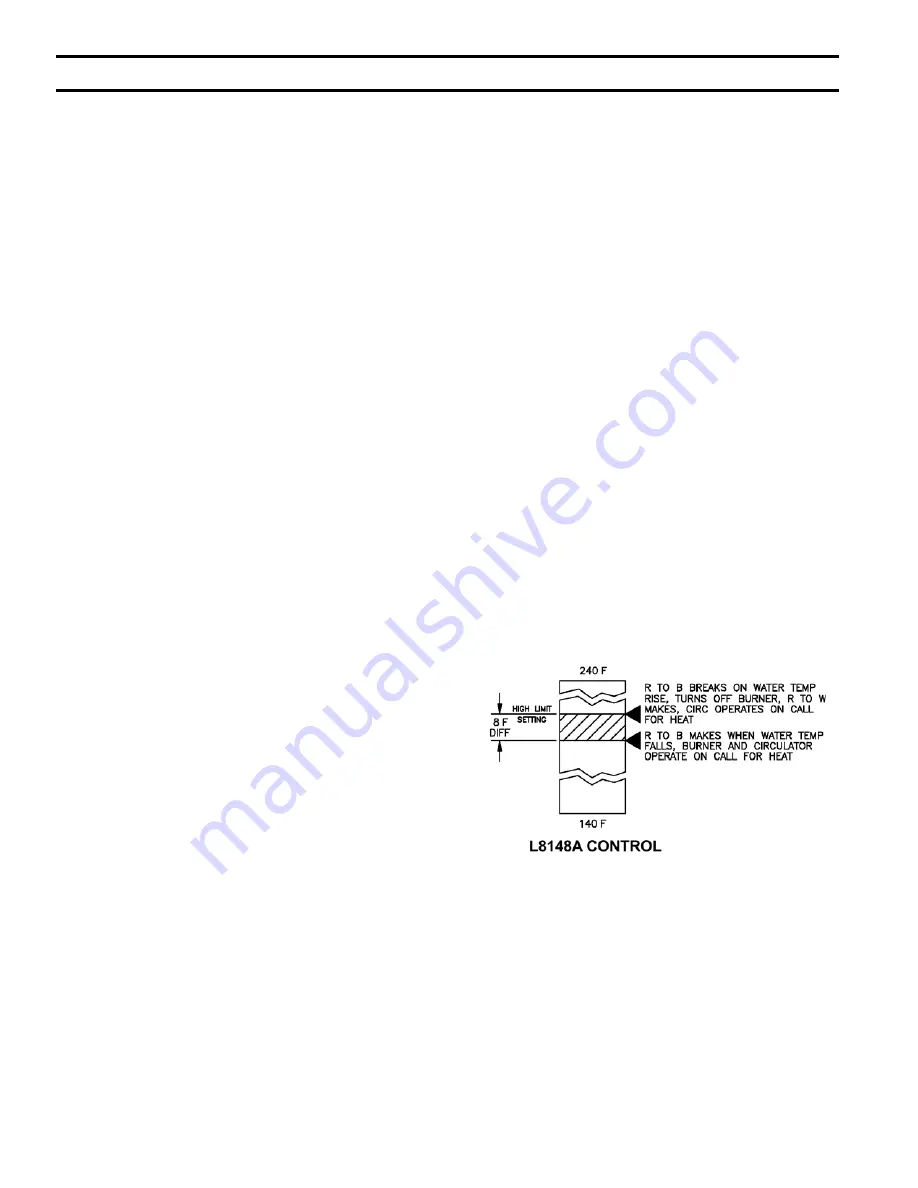
18
V. Electrical and Sequence of Operations
A
.
Electrical
1. Install wiring and ground boiler in accordance with
requirements of authority having jurisdiction, or in
absence of such requirements the National Electrical
Code, ANSI/NFPA 70, and/or the CSA C22.1
Electric Code.
2. A separate electrical circuit must be run from
the main electrical service with an over-current
device/disconnect in the circuit. A service switch is
recommended and may be required by some local
jurisdictions.
3. Wiring should conform to Figure 15.
B
.
Sequence of Operations
1. General
.
A call for heat by the thermostat energizes
the L8148A limit control which in turn energizes the
R7184P primary control to turn on the burner. The
circulator will operate as long as there is a call for
heat. If the call for heat is not satisfi ed and the high
limit setting is reached, the circulator will continue
to operate, and the burner will stop until the high
limit circuit is closed by a drop in boiler water
temperature.
2. L8148A Combination Limit control.
The switching action within the L8148A control has
one setting, the high limit. The switching relay is
controlled by the low voltage room thermostat. On
a call for heat, the relay contacts close to complete
the line voltage circulator circuit and also the burner
circuit if the boiler water temperature is below the
high limit setting. The high limit switch shuts off
the burner if boiler water temperature exceeds the
high limit setting. See Figure 14.
3. R7184P Oil Primary Control.
The R7184P operates the oil burner motor, solenoid
oil valve, and the ignition transformer in response to
a call for heat from the L8148A limit control.
a. A call for heat will energize the burner motor and
ignition transformer.
b. After a 15 second pre-purge period, in which
time a draft is established in the fl ueways, the oil
valve is opened.
c. If the burner ignites within 15 seconds from
the time the oil valve opens and the CAD cell
senses a fl ame, the ignitor is de-energized and
the burner will operate until the call for heat
is satisfi ed or the setting of the high limit is
reached.
d. A manual reset button is provided to reset the
safety switch after lockout.
e. When the call for heat ends, or the CAD cell
fails to sense a fl ame, the oil valve will close.
The combustion blower will continue to operate
for a postpurge period of approximately two (2)
minutes.
4. CAD Cell.
The Beckett AFII burners used on the microTEKDV
Series are supplied with a C554A Cadmium Sulfi de
(cad cell) Flame Detector to monitor the burner
fl ame and shut down the burner on ignition failure
or on fl ame failure during the run cycle. On either
failure, the manual reset button on the R7184P will
be tripped.
Figure 14: Control Differential
Summary of Contents for microTEKDV
Page 14: ...14 Figure 10 Vent Installation Figure 11 Vent Connector Un Assembled ...
Page 15: ...15 Figure 13 Air Intake Installation Figure 12 Vent Connector Assembled ...
Page 19: ...19 Figure 15 Schematic Wiring Diagram ...
Page 30: ...30 Figure 20 microTEKDV Boiler Jacket Insulation ...
Page 31: ...31 Figure 21 microTEKDV Bare Boiler Assembly ...






























